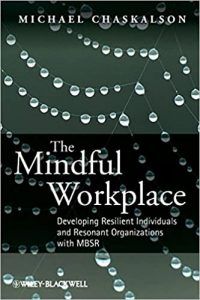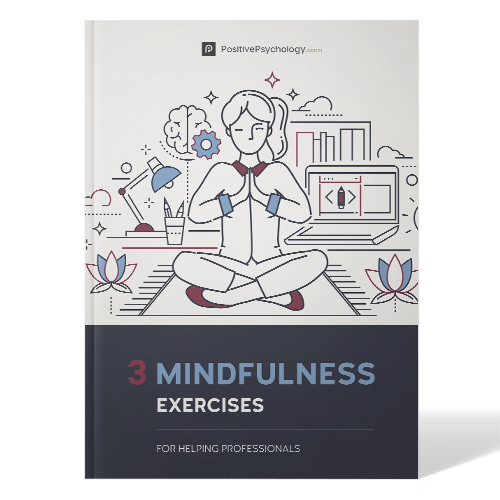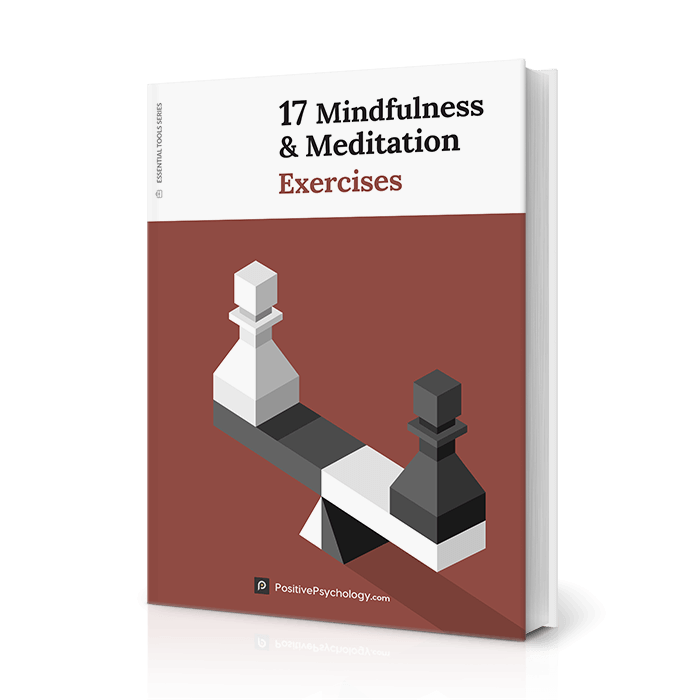Mindfulness at Work: Create Calm & Focus in the Workplace
 The workplace can be a fast-paced, stressful environment.
The workplace can be a fast-paced, stressful environment.
Is it possible to thrive, rather than flounder, in the work environment?
The key may lie with mindfulness – gently noticing what is going on for us, in the present moment, without passing judgment.
Though the research is somewhat lagging in the area of mindfulness at work and mindful leadership, it is nevertheless growing in interest. This article allows me to (hopefully) capture and share the power of mindfulness at work, and the article will also explore another relevant and related topic – mindful leadership.
As you read, perhaps take from the information what you can about how to be more mindful in your work and your leadership.
Before you continue, we thought you might like to download our three Mindfulness Exercises for free. These science-based, comprehensive exercises will not only help you cultivate a sense of inner peace throughout your daily life, but will also give you the tools to enhance the mindfulness of your clients, students, or employees.
This Article Contains:
- What is Mindfulness in the Workplace?
- Benefits of Mindfulness in the Workplace and Business
- Why is it Important?
- A Look at the Research
- 10 Examples of Mindfulness in the Workplace
- How to Introduce Mindfulness in the Workplace
- 14 Ways to Encourage Mindfulness at Work
- What Is Mindful Leadership?
- Cultivating Mindfulness Skills in Business
- How Does Mindfulness Look in Organizations?
- How to Develop A Mindful Organization
- Mindful Leadership Training
- Other Mindfulness in the Workplace Programs
- 7 Recommended Books
- 10 Mindfulness Quotes for Work
- A Take-Home Message
- References
What is Mindfulness in the Workplace?
Put very simply, workplace mindfulness is the degree to which individuals are mindful in their work setting (Dane & Brummel, 2013). What, then, does it mean to be mindful? Well, like so many constructs in positive psychology, mindfulness is not easily defined.
However, most definitions, such as the one described by Hyland, Lee and Mills (2015) share three elements.
Mindfulness can be described as a ‘present-focused consciousness’ (Hyland, Lee & Mills, 2015). In other words, a mindful individual is not ruminating about the past or worrying about the future; they are simply “being” in the here and now.
Secondly, mindfulness includes paying close attention to both internal and external stimuli (Hyland et al., 2015). Finally, as well as simply paying attention to stimuli, mindfulness involves doing this in an open and accepting way (Hyland et al., 2015). To summarise, a definition from Brown, Ryan and Creswell (2007): mindfulness is
“a receptive attention to and awareness of present moment events and experiences” (Brown et al., 2007: 212).
Mindfulness involves noticing what is happening without evaluating, analyzing or reflecting upon it – it is therefore said that mindful information processing is ‘pre-conceptual’ (Hülsheger, Alberts, Feinholdt & Lang, 2013).
Thus, a mindful employee will take in what is happening in the workplace and not react to it, rather, simply taking in information from their surrounds. They will non-judgmentally approach their work and their relations with other colleagues and management.
Although the majority of research into individual differences in mindfulness see it as a trait, many researchers now consider mindfulness to be a psychological state that varies from moment-to-moment within individuals (Hülsheger et al., 2013).
Furthermore, mindfulness has been described as a natural human capacity, which varies in regard to strength across both situations and persons (Hülsheger et al., 2013). What does this look like in the workplace?
Well, it means that throughout the working day, at any one time, employees’ mindfulness is variable; they may be closely paying attention, non-judgmentally, in a meeting – focused on whatever the presenter is talking about. Or, perhaps, later in the day they are less mindful and are sitting staring at the computer wondering what to cook for dinner.
So, the person has the capacity to be mindful, however their mindfulness at any one time is variable.
Benefits of Mindfulness in the Workplace and Business

Speaking very generally, there are some mindfulness-based processes that are thought to affect employee performance and wellbeing.
These include response flexibility, decreased rumination, empathy, affect regulations, increased self-determination and persistence, improved working memory and more accurate affective forecasting (Glomb, Duffy, Bono, & Yang, 2012).
Benefits of mindfulness in the workplace also include improvements in task commitment, and enjoyment of work (Hyland et al., 2015). Let’s have a look at some of the work-related benefits of mindfulness in some more detail…
Improved social relationships
Mindfulness results in improved social relationships (Glomb et al., 2012). Positive workplace relationships can have a significant impact. They buffer the effects of workplace stressors, promote thriving in employees, and foster communication, creativity and citizenship behaviors (Glomb et al., 2012).
Glomb et al. (2012) suggest that mindfulness promotes positive social connections in the workplace through a number of integral mindfulness processes, but most especially empathy and response flexibility.
Employees who practice being mindful are therefore more likely to show greater acceptance of colleagues without reactivity (Glomb et al., 2012). Optimal functioning of organizations is, in many ways, dependent upon positive interpersonal relationships.
Given that some studies have suggested that training in mindfulness may be linked to social connectedness, this highlights the important role that mindfulness may play in workplace relationships and the success of the organization (Glomb et al., 2012).
Mindfulness and resilience
A benefit of mindfulness in the workplace is that it promotes resiliency. Glomb and colleagues (2012) nominate two processes associated with mindfulness as being likely to foster resilience: affective regulation and persistence.
Mindfulness helps individuals to approach others positively and, in addition, it protects them from the negative emotions and agitation of another person by regulating affect appropriately and decreasing reactivity (Glomb et al., 2012).
In the workplace, resiliency is at the face of interpersonal or task-related stressors, and is also a vital part of optimal work functioning.
Enhanced task performance
Mindfulness also improves task performance.
The way that mindfulness is implicated in workplace performance is dependent on the nature of the task, and the contextual factors of the work… some mindfulness processes will beneficially affect a variety of types of job, whereas others are more specific (for example, for jobs with a lot of emotional content, decreased rumination and improved affective regulation may hold the key to performance) (Glomb et al., 2012).
It has also been found that mindfulness is associated with fewer cognitive failures (such as forgetting, distraction and blunders) – which suggests that mindfulness may therefore lead to improved workplace performance and fewer accidents (Glomb et al., 2012).
Improved intuition
Mindfulness also promotes an awareness of ‘gut feelings’ and it has been suggested that tapping into these intuitions may facilitate improved task performance when the level of expertise is high (Glomb et al., 2012).
Furthermore, mindfulness is also thought to promote better decision making, with decision biases being less likely due to attention to internal and external stimuli, and reduced heuristic processing.
As you can see, the benefits of mindfulness in the workplace are many and varied.
Why is it Important?
Mindfulness in the workplace is important for a wide range of reasons. The first relates to how satisfied an employee is in their job – which clearly has implications for their wellbeing, psychologically, and emotionally.
Job satisfaction and motivation
Affective events theory has been applied to mindfulness in the workplace by suggesting that mindfulness may be positively related to job satisfaction, because mindfulness facilitates more adaptive appraisals of work stressors (Hülsheger et al., 2013).
In other words, when something challenging happens at work, a mindful employee will not simply react and judge what is happening emotionally, rather they will consider it with a more adaptive stance. Therefore, by construing the stressor at work with a more proactive approach, the employee will also be more satisfied in their work.
Furthermore, mindfulness may also relate to job satisfaction because it increases self-determined behavior (Hülsheger et al., 2013). Self-determined behavior is behavior that is consistent with an individual’s needs and values (Hülsheger et al., 2013).
Mindfulness also promotes awareness of an individual’s basic values and needs because it decreases habitual and automatic functioning and brings attention and awareness to experiences in the present moment (Hülsheger et al., 2013). The relationship between mindfulness and job satisfaction will be explored in the next section, where research is considered.
Work stress and mindfulness
Another reason why mindfulness is important is because it can help combat and manage employee stress (Hyland et al., 2015). Chronic stress is a widespread problem in society, perhaps most especially at work.
According to the National Institute for Occupational Safety and Health (1999), 26% of workers say that they are “often or very often stressed at work” (Hyland et al., 2015). Workplace stress has a significant impact not only on individuals, but also the effectiveness of organizations.
Going back all the way to 1990, workplace stress cost American business as much as $150 billion every year… Mindfulness training has proven benefits for employee health and wellness, including to help decrease workforce stress and build resilience (Hyland et al., 2015).
Leadership development
Mindfulness can even help improve high potential development in business. In 2013, 35% of the total spending on training in US organizations went on leadership development (Hyland et al., 2015). However, despite this expenditure, three quarters of all CEOs still nominate leadership development as a top business concern (Hyland et al., 2015).
A lack of self-awareness is found to be the single biggest factor in derailment of high potential leaders. Thus, given that awareness of self and others is a component of mindfulness, increasing mindfulness will also be associated with increased self-awareness.
This also suggests that mindfulness plays a role in the success of high potential employees, and the effectiveness of processes that organizations have in developing high potential (Hyland et al., 2015).
Enhanced employee engagement
Mindfulness is also important in the workplace because it can enhance engagement and decrease burnout (Hyland et al., 2015).
It is shown that employees’ investment in their jobs is associated with greater employee satisfaction, lower intention of turnover and increased organizational citizenship behaviors (Hyland et al., 2015).
This employee engagement has been linked to mindfulness. Mindfulness has been shown to relate both to increased performance and decreased intention of turnover (Hyland et al., 2015). Mindfulness programs may enable organizations to foster employee engagement and commitment – especially in the case of high-stress and high-burnout jobs (Hyland et al., 2015).
Coping with change
Mindfulness can also help employees cope with organizational change (Hyland et al., 2015). These days, change is a predominant feature of the workplace.
Research shows that a large reason why efforts for workplace change often fail is employee resistance. Mindfulness can help employees cope with change – it may reduce the stress that is associated with loss of job control that often occurs with organizational change (Hyland et al., 2015).
Increased mindfulness is also associated with lower levels of ego-defensive reactivity under threat, and it promotes objectivity, both of which help an individual cope with change in the workplace (Hyland et al., 2015).
A Look at the Research

Nevertheless, we take a few moments to examine the research that has looked at mindfulness in the workplace.
Research into mindfulness, as a general construct, has been studied by employing a wide range of methodological approaches: survey designs, experimental studies, cross-sectional and longitudinal studies (Hyland et al., 2015).
Examples of instruments designed to measure mindfulness are the FMI and the MAAS.
The FMI is the Freiburg Mindfulness Inventory, which has both a long form (30 items) and a short form (14 items) (Hyland et al., 2015). Both forms have been shown to be psychometrically sound (Hyland et al., 2015).
The MAAS is the Mindfulness Attention and Awareness Scale, consisting of 15 items (Hyland et al., 2015). This scale can distinguish between people who have various levels of experience with mindfulness. So, now that you have an understanding of what mindfulness research looks like, let’s take a closer look at mindfulness in the workplace context.
Coping and calm
In 2008, Hunter and McCormick conducted a small exploratory qualitative study, examining a range of workplace outcomes derived from mindfulness practice for eight managers and professionals.
These outcomes included heightened awareness of external stimuli, greater acceptance of an individual’s work situation, increased coping ability and the ability to remain calm in stressful/challenging work situations, better adaptability and more positive workplace relationships.
Hunter and McCormick analyzed the interviews they conducted, and found out a number of things about employees who practice mindfulness. They found that individuals who practice mindfulness have more modest, realistic work goals, are more selfless and are less concerned with material acquisition and wealth (Hunter & McCormick, 2008).
They also found that mindful individuals are more likely to find meaning in life from sources other than work (Hunter & McCormick, 2008).
Affect and mindfulness-based interventions
Tamara Giluk (2010) conducted research that looked at outcomes from employees’ participation in either the Mindfulness-Based Stress Reduction (MBSR) program or the Mindfulness-Based Cognitive Therapy (MBCT) which were conducted at the University of Iowa. The findings of this particular study were limited by a very low sample size, the study thus lacked statistical power.
The study did show, however, that mindfulness was significantly related to positive affect and negative affect, but that no correlation was found with the quality of relationships or job performance.
Stress and mindfulness
Allen and Kiburz (2012) looked at mindfulness as a trait. Their study showed that greater trait mindfulness was associated with greater work-family balance (Allen & Kiburz, 2012). It also found that trait mindfulness predicted improved sleep quality, and increased vitality (Allen & Kiburz, 2012).
Galantino and colleagues (2005) were interested in stress and mindfulness. They looked at subject-reported stress symptoms, as well as salivary cortisol (a known indicator of stress levels) in health-care professionals (Galantino, Baime, Maguire, Szapary & Farrar, 2005).
An 8-week long mindfulness meditation program was implemented. Mindfulness meditation was found to be related to significant decreases in employees’ emotional exhaustion (Galantino et al., 2005). It was discovered, however, that changes in salivary cortisol and subject-reported stress symptoms from baseline to 8 weeks post-program completion were weak and not statistically significant (Galantino et al., 2005).
Mindfulness, emotional exhaustion, and job satisfaction
Following on from Galantino’s work, Hülsheger and colleagues (2013) looked at the relationship between mindfulness, emotional exhaustion and job satisfaction in a sample of interactive service workers. Their research looked at jobs that require employees to interact directly with customers/clients which means that they are often faced with emotionally charged encounters.
These employees therefore need to manage their emotions as an inherent part of their job. This form of ‘emotional labor’ means that these employees are generally more likely to experience emotional exhaustion and decreased job satisfaction, because these factors relate to other important organizational outcomes, including task and contextual performance, staff turnover and absenteeism (Hülsheger et al., 2013).
Study 1:
The first study conducted by Hülsheger et al. (2013) was a 5-day diary study involving 219 employees. Mindfulness was found to be negatively related to emotional exhaustion and positively related to job satisfaction, at both the within and between person levels. Surface acting mediated the relationship between mindfulness and job satisfaction and emotional exhaustion at both levels of analysis (Hülsheger et al., 2013).
Perhaps you are wondering what surface acting is? Put simply, surface acting refers to an emotion regulation strategy involving the suppression of negative emotions and ‘faking’ positive emotional expressions in jobs in which positive emotional displays are expected.
Study 2:
Hülsheger et al.’s (2013) second study looked at 64 participants who took part in the experimental field study. The individuals either took part in a mindfulness intervention or were assigned to a wait-list control group. It was found that participants in the mindfulness intervention group reported significantly less emotional exhaustion and greater job satisfaction than those in the control group.
Findings of Hülsheger et al’s (2013) research suggests that mindfulness promotes job satisfaction in emotionally draining work roles, and that it can also help to prevent burnout caused by emotional exhaustion.
10 Examples of Mindfulness in the Workplace
To begin this exploration of examples of mindfulness in the workplace, consider a ‘real-life’ example.
Take a physiotherapist. The physio, practicing mindfulness, was fully engaged in giving a client a massage and she felt every movement of her hands and fingers quite intensely. Now, to explore more general examples of mindfulness in the workplace…
The following are examples of how to be more mindful in the context of a busy day at work. Applying principles of mindfulness can help employees feel more active and present, and they are therefore more productive (Alidina, 2018).
1. ‘Be consciously present’ (Alidina, 2018).
Rather than simply behaving quite unconsciously, being mindful at work involves paying attention to what is going on around you, and also what is going on for you internally. Being mindful at work involves being consciously present in the task you are doing – for example, if writing a report, being mindful means that you give that task your full attention.
When your mind wanders (which it will), acknowledge the presence of those thoughts then refocus your attention to the work you are doing.
One way to help develop mindfulness in the workplace is to set a moment aside at the beginning of each day to make a clear decision to be as present as possible at work that day (Alidina, 2018).
2. ‘Use short mindful exercises at work’ (Alidina, 2018).
Practicing mindfulness regularly helps train the brain, such that the brain can then drop into a mindful state easier. It also optimizes the brain’s functioning. However, obviously in the workplace it may be impossible to set aside 30 minutes or so to engage in a mindful exercise (Alidina, 2018).
This doesn’t matter.
Mindful exercises can be as short as you like. To incorporate mindfulness into your day, be creative with finding opportune times that you can fit it in (Alidina, 2018).
3. ‘Be a single-tasker’ (Alidina, 2018).
In other words, an example of being mindful at work is to only do one thing at a time. Nobody can actually multi-task. It is also very inefficient.
Need help to stop multi-tasking?
One suggestion by Alidina (2018) is to keep a time journal. In it, write what is achieved in a block of time, and then look at when you’re ‘single tasking’ and when you’re ‘multi-tasking’. Then, reflect on how mindful you were and what you achieved.
4. ‘Use mindful reminders’ (Alidina, 2018).
It is very easy to slip back into ‘auto pilot’ – especially as this is the brain’s ‘default’ way to operate. Therefore, it is helpful to use some form of reminder to help you be mindful again.
Alidina (2018) suggests that you could set your phone to ‘vibrate’ and associate the phone with being more mindful – without disturbing others in your workplace. Then, for example, when you aware of receiving a text message or other notification, instead of immediately reacting by checking your phone, pause and take a moment to be mindful (Alidina, 2018).
5. ‘Slow down to speed up’ (Alidina, 2018).
Slowing down, or even stopping, can help workers become more efficient, productive, happier, resilient, and healthy at work. In other words, the mindful way of working is to slow down and reflect. It is somewhat counter-intuitive, but slowing right down actually makes us more productive and efficient.
6. ‘Make stress your friend’ (Alidina, 2018).
Sounds bizarre, doesn’t it?! Well, research has shown that the beliefs that a person has about stress actually impacts upon their health and wellbeing (Alidina, 2018). Studies have found that, even if people experience high levels of stress, if they believe that stress is actually good for them, they had the lowest mortality rates.
Mindfulness can help to change the way you think about stress so that you can ‘make it your friend’. When faced with a workplace challenge, simply have an awareness of your body’s natural reaction.
Take the time to observe the quickening of your heart rate, and then remind yourself that this stress response is energizing you – be grateful (Alidina, 2018). This will help you to view the problem instead as a positive challenge, and shift your attitude towards stress – thus, improving productivity and achievement at work.
7. ‘Feel gratitude’ (Alidina, 2018).
An example of mindfulness is to be grateful. Being mindful of the things that are going well at work can also help develop resilience too. Be grateful for the little things, and even the challenges that come with the inherent nature of work.
8. ‘Cultivate humility’ (Alidina, 2018).
What, you ask, does humility have to do with mindfulness in the workplace? How is it an example of being mindful?
Well, consider the components of mindfulness.
Mindfulness involves self-acceptance and being open to listening and learning from others. This necessarily leads to humility. Mindfulness is also tantamount to gratitude, as just explained – in other words, to be mindful is to appreciate how others have helped you. According to Alidina (2018), someone who is grateful is also, by implication, humble.
9. ‘Accept what you can’t change’ (Alidina, 2018).
Mindfulness in the workplace is characterized by acceptance. To be mindful is to accept the present moment for what it is.
It also includes accepting yourself simply the way you are. Accepting mistakes at work can reduce unhelpful ways of dealing with perceived ‘failure’, such as denial or avoidance. Both of these unhelpful strategies hamper work efforts. Therefore, an example of being mindful at work is to practice ‘radical’ acceptance.
10. ‘Adopt a growth mindset’ (Alidina, 2018).
Mindfulness in the workplace involves being in the present and not judging your innate talent or intelligence – rather, being open to new possibilities (or, to put simply, adopting a ‘growth mindset’).
What does this look like?
Well, for example, if you get some negative feedback at work, you will not be deterred because you can see that you now have the chance to discover something new. You will view new responsibilities with a sense of curiosity as to how you will cope.
The essence of mindfulness at work is “believing that you can improve and grow with experience, moving towards challenges, living in the moment, and discovering new things about yourself and others’ (Alidina, 2018).
How to Introduce Mindfulness in the Workplace
Introducing mindfulness in the workplace helps to decrease stress and promote productivity and efficiency among team members (Forbes Coaches Council, 2018).
The first step in introducing mindfulness to the workplace is to be clear about the purpose for introducing mindfulness and also to know the part of the business strategy that will handle it (Mudd, 2017).
The aim may be to introduce it as a wellbeing program.
Or, it may be a part of a shift in the culture of an organization to develop a different leadership style and alternative way for employees to work (Mudd, 2017). It is also important to be clear about what the benefits of mindfulness are, and in particular what your organization will gain.
The role of leadership
In introducing mindfulness to the workplace, senior management plays an important role. Not only playing a physical role, it is also necessary for managers in the organization to take ownership of the initiative, to discuss it and answer any questions about it (Mudd, 2017).
It is a good idea to implement ‘taster’ sessions – not everyone finds mindfulness beneficial, and it has been shown that the most productive workplace programs are those in which employees ‘opt in’ (Mudd, 2017). It is also important for an experienced and skilled practitioner to conduct the mindfulness sessions.
To introduce mindfulness, “recruit internal champions” (Mudd, 2017). In other words, in the introductory phase, these chosen employees can be ‘visible’, endorse the mindfulness training and encourage their colleagues to take part. These employees may host and reinforce the regular mindfulness sessions after the initial formal training period (Mudd, 2017).
To promote mindfulness practice, encourage staff to take regular breaks including a proper lunch break (Team MyHub, 2018). By completely detaching from work, even if only for 15 minutes, means staff are more able to concentrate and also be more alert and refreshed.
Be patient
An important aspect to consider when introducing mindfulness is to accept that there is no immediate solution. Mindfulness takes time and a sustained effort, and scheduling and delivery of formal training also needs to be flexible (Mudd, 2017). As well as formal training, the sessions should be enhanced by simple mindful working practices that can be incorporated into the daily work routine (Mudd, 2017).
One idea for introducing mindfulness in the workplace is to create a designated ‘quiet space’ (Team MyHub, 2018). As well as giving employees a space in which to meditate, the room also provides employees with a space to refocus without the multitude of distractions in the workplace (emails, phones, office chatter, etc).
The quiet room could have calming photos or images from nature, or even positive images reflecting the mission of the company (Team MyHub, 2018).
To introduce mindfulness in the workplace, it is worthwhile to look at the outcomes the workplace wants from mindfulness, and what is needed for it. Then, before you start implementing the mindfulness, ensure the goals are Specific, Measurable, Achievable, Realistic, and Time-bound – i.e. SMART goals (Mudd, 2017).
It is also a good idea to establish the relevance of mindfulness for the business or organization and to verify the sustainability of the proposed program (Mudd, 2017).
Finally, make sure that the program is feasible in terms of scope and timescale (Mudd, 2017).
Mindfulness at work – Shanel Munger
14 Ways to Encourage Mindfulness at Work
Hopefully from reading through the previous sections, you are now convinced that mindfulness should be encouraged in the workplace. How can this be done? Well, the Forbes Coaches Council (2018) have put forward 14 suggestions of ways to encourage mindfulness in the workplace.
Here they are:
- Lead by example – In other words, be what you are asking others to become. Take the time to practice mindfulness yourself at work, and you will encourage others to do so.
- Give people time to dream – Cultivating mindfulness and a sense of peace, even through day-dreaming, can lead to ideas that are beneficial and potentially revenue raising.
- Look at your response from another’s point of view – This involves making sure you are clear, calm and confident when sending an email, making a phone call, or beginning a meeting. Take the perspective of others in workplace interactions into consideration.
- Ask challenging questions – Challenge employees to act and think.
- Get up and take a break – Step away from the desk. Look away from the computer. Also, let your team see that you take breaks, and they will feel more comfortable in doing so too.
- Teach people how to practice mindfulness – This can also raise the overall level of consciousness in the workplace.
- Remember to breathe.
- Notice the little things around you – Appreciating seemingly minor events or stimuli is one way to encourage mindfulness.
- Lead with emotional connection – Be emotionally present and address emotional blocks to fully understand the reality of others and develop an emotional alliance in order to help people overcome challenged.
- Allow ‘gap time’ between meetings – To encourage mindfulness, put a short break in between scheduled meetings. It only needs to be 5 – 10 minutes, but the ‘gap’ will help employees to increase focus, be more productive, and have greater wellbeing.
- Slow down and block “unscheduled” time for yourself – As was mentioned previously in this article, slowing down is the best thing to do in order to foster mindfulness.
- Don’t be a ‘micro manager’ – Be aware of the fact that stress is a major block to mindfulness, and that micro-management is one of the biggest sources of stress in the workplace.
- Incorporate mindfulness into meetings – At the beginning of a meeting, allow a couple of minutes to engage in contemplative practice: meditate, set intentions, and take a few deep breaths.
- Start a conversation about mindfulness.
The notion of mindfulness may be overwhelming if people are not informed about it. An effective thing to do would be to encourage team members to share which techniques work for them with other employees who may struggle with the concept of being mindful.
What is Mindful Leadership?
Leadership plays an important role in the workplace and in business.
Mindful leadership involves a leader harnessing the power of mindfulness in directing their staff.
Mindful leadership can result in widespread transformation in the work arena. It sees a leader having an awareness that their role as leader is to serve others (Mindful Leader, n.d.). It involves the leader developing self-awareness and compassion in order to inspire others, and leading their team with authenticity (Mindful Leader, n.d.).
Mindful leaders have a high level of self-understanding (Marturano, n.d.). They are not scared to have an open mind and an open heart. Mindful leaders possess a strength of character that enables them to make sound ethical decisions (Marturano, n.d.).
Mindful leadership is a relatively new kind of leadership, characterized by a ‘presence’ that allows the leader to encounter more, and different, ways in which to influence the lives of others (Marturano, n.d.). A mindful leader can influence individuals in their team, organization, family and community (Marturano, n.d.).
Cultivating Mindfulness Skills in Business
In this discussion of promoting mindfulness skills, I will focus on two slightly different perspectives – firstly, looking at some research, and then, some practical suggestions.
What does research say about mindfulness-based interventions in the workplace? Evidence-based Mindfulness-based Stress Reduction (MBSR) has consistently been shown to have behavioral, psychological, and physiological benefits. Yet it can be extremely difficult to implement in the workplace due to the substantial time commitment it requires of participants (Klatt, Buckworth, & Malarkey, 2009).
Klatt and colleagues investigated this by introducing a shortened ‘low-dose’ (ld) MBSR intervention in the workplace.
Klatt et al.’s (2009) study found that the MBSR-led group had significant reductions in perceived stress and increases in mindfulness, and that, as well, these individuals self-reported improved sleep quality. It therefore seems that indicators of stress in healthy working adults could be found to have similar results to traditional MBSR with a short-term intervention delivered in the workplace (Klatt et al., 2009).
Klatt et al.’s research suggests that one way to cultivate mindfulness skills in business (and to achieve the benefits from this) is to implement an effective evidence-based intervention. However, alternatively, there are also some simple steps which can provide an alternative to a formal intervention and promote mindfulness skills.
- The first way to cultivate mindfulness skills is to identify stress and analyze your responses (Quast, 2018). Look over the past few weeks, and note three events that were especially stressful for you. Then, consider your response to each of these events… did you get mad? Or did you avoid dealing with the event altogether? Or, did you slow down, take a nice, deep breath and go for a gentle stroll (or fast-paced power walk) outside, to help clear your mind?
- Next, think about which of these behaviors helped you to cope with the stress. Be mindful of the fact that our bodies react physically to stress – this allows you to recognize stress, to lessen the effect of automatic responses and have greater control, by choosing the best way to respond (Quast, 2018).
- To cultivate mindfulness skills, practice patience. For example, don’t react to things straight away. In order to develop mindfulness, avoid making instant decisions – instead, sit with the decision. Try and find out more information, and discover a different point of view. To practice patience, use the ‘STOP’ acronym as a reminder to: Stop, Take a breath, Observe, and Proceed (Quast, 2018). Being patient at work can also help an employee to consider the ‘bigger picture’ and to consider alternative viewpoints.
- In order to develop mindfulness skills in business, cultivate humility. By practicing humility, the employee can be assisted to accept themselves – including their unique strengths and weaknesses. Humility also promotes a nonjudgmental stance in seeing others who they are, and also to avoid overconfidence and arrogance.
Taken together, it can be seen that there are some simple methods – as well as proven interventions – for cultivating mindfulness skills in business.
How Does Mindfulness Look in Organizations?
I will look at this question from two angles: what mindfulness training looks like in organizations, and also what mindfulness looks like ‘in action’ within the workplace…
In previous times, mindfulness training in workplaces predominantly took the form of slightly adjusted MBSR programs (Hyland et al., 2015). Over time, a more separate form of mindfulness training has emerged in workplaces.
Basically, like the MBSR-ld mentioned previously, MBSR programs have been adjusted to fit in with the work environment – such as being shorter courses designed so that employees take less time away from work tasks (Hyland et al., 2015).
The courses vary in length, expected commitment to daily practice, and form. For example, some MBSR programs consist of 60 – 90-minute classes run over 5 – 12 weeks, while some are one-off, multi-day retreats (Hyland et al., 2015). Some programs are now even available online so employees can even participate from their desks (Hyland et al., 2015).
What mindfulness at work looks like
Now that we have covered what mindfulness training looks like in organizations, let’s now shift our focus to the observable features of mindfulness as they may occur in the workplace.
To begin with, mindful employees have an intensified focus (Search Inside Yourself, n.d.). Their stress is managed well and controlled, and they are resilient in the face of inevitable workplace challenges (Search Inside Yourself, n.d.).
Mindful employees show creativity and innovative thinking, as well as greater self-awareness (Search Inside Yourself, n.d.). They display superior emotion regulation and communicate clearly and effectively (Search Inside Yourself, n.d.). Finally, mindfulness in organizations is characterized by employees who have greater overall wellbeing.
How to Develop a Mindful Organization
How can a business develop mindfulness? Corporate mindfulness programs are still in their infancy.
So far there is no unified approach amongst leaders of corporate mindfulness programs.
However, it is accepted that mindfulness programs should be put together considering a balance between both personal development and team performance (Razzetti, 2018).
Developing a mindful organization could include providing educational tools and resources (Dhanik, 2017). The organization could arrange for workshops for employees or assign a particular room as a ‘meditation room’.
It is also important to remember that developing mindfulness in an organization does not necessarily need to be in the shape of formal meditation practice (Dhanik, 2017).
Some employees may find formal meditation too intimidating – there are many activities that can help employees to focus and be mindful. It is also not enough to simply provide resources to develop a mindful organization. What is important is to consider mindfulness not as an activity but as a mindset.
“It’s less about what you do at work than how you do it” (Razzetti, 2018).
It is also important to promote a mindfulness program. Internal communication is important to introduce mindfulness and have employees adopt it (Dhanik, 2017). It is a good idea to provide the team with education about the positive outcomes from having a ‘quiet mind’.
Aetna – A Mindful Organization
The insurance company, Aetna, took a holistic tactic to develop a mindful organization. It actually achieved a transformation of the culture of the business, and is therefore one of the prime examples of an effective corporate mindfulness program (Razzetti, 2018). How did Aetna develop a mindful organization?
To start with, the shift in Aetna’s workplace culture was authentic. The CEO, Mark T. Bertolini, had a very serious skiing accident and whilst he managed to pull through, conventional treatments didn’t help him to overcome his pain. He developed a practice of yoga and mindfulness meditation, and Bertolini wanted his employees to experience the benefits of those practices too (Razzetti, 2018).
To develop a mindful organization, any programs offered should be voluntary. Aetna’s yoga and meditation programs are optional, and there are no incentives offered for participation. It is also important to provide a context for mindfulness programs.
For example, Aetna prioritised improvement of employees’ overall wellbeing – productivity was a secondary concern. It also helps to be clear with the team about why the program is in place and what it hopes to achieve (Razzetti, 2018).
Starting Slow
Razzetti (2018) advises organizations to ‘start slow’. For example, Bertolini began by leading short mindfulness meditations simply to his executive team at Aetna. Some individuals liked it, others were doubtful. Razzetti also explains that it is necessary to make connections with business outcomes.
For example, Aetna found that employees who took part in the mindfulness program had, on average, a 28% decrease in stress levels and 20% improvement in sleep quality. What’s more, the business’s productivity rose by an average of 62 minutes per week, and the stock hit a record that was unseen before.
Whilst the mindfulness program wasn’t the sole reason behind those business outcomes, it certainly played an important part.
Take a Holistic Approach
Razzetti (2018) also explains that offering employees financial wellbeing is consistent with a culture of mindfulness. Aetna increased its’ staff’s minimum wage by 33%. Razzetti (2018) also suggests that it is important to take a holistic approach when developing a culture of mindfulness in an organization – wellness and mindfulness are interrelated.
For example, as well as introducing mindfulness, the organization could look at another wellbeing initiative – such as a ‘healthy breakfast’ club, lunchtime walking groups or free yoga.
Design Thinking and Workspaces
In developing a mindful organization, the workspace is also important. For example, the CEO and founder of Provenir Healthcare, Brigitta Glick, began the business with mindfulness a key consideration. She was clear that she didn’t want the office to be like the usual corporate environment (Razzetti, 2018).
She ensured that every employee would be exposed to natural light, and whilst every employee wouldn’t necessarily get a private office, many of the offices are unassigned and could be used on a first come, first served basis (Razzetti, 2018).
Lead by Example
Development of a mindful organization is highly dependent on leadership (Razzetti, 2018). Managers should lead by example, by using the resources available themselves as well as promoting the use of resources with their team (Dhanik, 2017). Leaders have to support mindfulness personally in order to try and encourage a mindful workplace.
Authentic, compassionate leadership is required to develop a culture of mindfulness. Furthermore, trust is important – when staff trust one another, they can bring their ‘best selves’ to work (Razzetti, 2018).
Razzetti (2018) puts forward several suggestions to develop a mindful organization. To begin with, he suggests designing a ‘big’, ambitious program but to start off delivering it to a small group. He also emphasizes the need to be authentic: “it’s hard to convince others of a mindset you are not willing to model” (Razzetti, 2018).
Razzetti (2018) also explains that providing individual activities can allow employees to practice and experiment without feeling too exposed – he points out that mindfulness can lead an individual to feel vulnerable.
Feedback and Measurement
Razzetti (2018) recommends tracking the relationship between a team’s wellness, attitudes and productivity, and balancing both the transformation of individuals and the business. Consistency is another important aspect to look at when developing a mindful organization.
Razzetti advises businesses to take a holistic approach, both to leadership and decision-making. A successful corporate mindfulness program should combine aspects for the body, mind, space and culture (Razzetti, 2018).
A final suggestion as to how to develop a mindful organization is to embrace technology (Dhanik, 2017). There is a very wide range of guided meditation apps, including Headspace and Buddhify. One option may even be to reimburse employees for the costs associated with the apps (Dhanik, 2017).
Mindful Leadership Training

Mindful leadership training teaches those who are in positions of leadership in the workplace to have a number of qualities. It involves the leader learning how to lead their own life skillfully, and this enables them to lead others with wisdom and clarity.
It also teaches leaders to have self-confidence, and to have tolerance and wisdom in accepting who other people are.
Mindful leadership training results in leaders being able to lead with courage, integrity and authenticity.
Mindful leadership training seeks to develop leadership presence. However, to be a mindful leader, an individual must first be mindful of themselves. A mindful leader has an awareness of their personal qualities as well as their strengths and challenges.
Mindful leadership training looks at the way that meditation, reflection and other contemplative practices have an effect on promoting the qualities of leading, and living, with excellence.
Leaders are taught a number of skills they can apply to manage others in the workplace. For example, participants are taught to get in touch with the natural capacities of the mind to develop and promote traditional business and leadership expertise.
Mindful leadership training enables individuals to discover creative solutions by helping them to learn to feel comfortable with uncertainty and adversity. It encourages participants to practice applications of the mindful leadership training on a daily basis to foster mental and physical resilience.
It provides them with the skills to initiate, and/or make workplace change skillfully by tapping into intuition and connecting fully with others.
Finally, mindful leadership training helps leaders notice and acknowledge unproductive patterns, both in workplace interactions as well as within themselves. Leaders develop the skills to respond in a way that is more effective.
Other Mindfulness in the Workplace Programs
Other mindfulness in the workplace programs include ‘Search Inside Yourself’, Smiling Mind and programs delivered by the Mindfulness Institute, CA. Let’s have a look at each of these programs.
Search Inside Yourself
Search Inside Yourself is a program teaching practical mindful leadership as well as emotional intelligence (Search Inside Yourself Leadership Institute – SIYLI, n.d.). The program was established at Google back in 2007. A group of mindfulness, neuroscience and emotional intelligence experts came up with an internal course for users of Google (SIYLI, n.d.).
However, there was so much interest from outside Google that the S.I.Y. Leadership Institute (SIYLI) was formed in 2012 as an independent non-profit organization.
The S.I.Y. program aims to equip employees or teams with compassion, empathy and wisdom based on mindfulness skills. More than 20,000 individuals have undertaken the SIY program in over 100 cities around the world. The program consists of two days live training, followed by a 4-week online program (‘virtual practice’) and also a webinar.
Smiling Mind
‘Smiling Mind’ is an Australian based company which delivers mindfulness-based programs in workplaces to help employees become less stressed and more productive (Smiling Mind, n.d.). The company develops packages to help “create a mindful culture where your staff want to turn up, connect with purpose and join you on your business journey” (Smiling Mind, n.d.).
Smiling Mind helps employees develop mindfulness skills and use tools to take a pre-emptive approach to manage their mental health, stress and emotions in the workplace. Their approach combines professional learning for staff as well as providing access to the Smiling Mind digital learning platform (Smiling Mind, n.d.).
This technology provides workplace participants with ongoing and sustained implementation of the program. The face-to-face training programs include a 60-minute Introduction to Mindfulness program and a series of 4 60-minute workshops. Workplaces also have the opportunity to take part in a customized Bespoke Workshop (Smiling Mind, n.d.).
The Mindfulness Institute
The Mindfulness Institute in California delivers a range of programs. The workplace mindfulness programs are based on the MBSR program, and aim to foster conscious awareness, providing participants with the skills to work on patterns of thought, emotions, behavior and interpersonal interactions in all aspects of their lives (The Mindfulness Institute CA, n.d.).
This enables the program participants to consciously navigate life both at work, and also at home.
The Mindfulness Institute customizes its’ programs to meet each workplace’s unique needs. Programs are generally delivered at a site provided by the workplace. They take various forms, such as a full or half-day workshop, through to 1.5 – 2-hour sessions held once a week for four or more weeks (The Mindfulness Institute CA, n.d.).
The programs may include a guest speaker, and the Institute can even organize executive retreats at a chosen location.
Components of the Mindfulness Institute, CA’s custom designed programs may include mindful eating, mindful movement, working with compassion, other aspects of mindfulness meditation, interpersonal mindfulness and mindful communication. The cost varies, according to the format, length of program and number of participants.
7 Recommended Books

Here are seven books that you may enjoy.
- The Mindful Leader (Carroll, 2007) (Amazon)
- Awake at Work (Carroll, 2004) (Amazon)
- Resonant Leadership: Renewing yourself and connecting with others through mindfulness, hope and compassion (Boyatzis & McKee, 2005) (Amazon)
- Mindful Leadership: The 9 ways to self-awareness, transforming yourself, and inspiring others (Gonzalez, 2012) (Amazon)
- Mindful Work: How meditation is changing business from the inside out (Gelles, 2015) (Amazon)
- The Mindful Workplace: Developing resilient individuals and resonant organizations with MBSR (Chaskalson, 2011) (Amazon)
- Mindfulness at Work: How to avoid stress, achieve more, and enjoy life! (McKenzie, 2013) (Amazon)
10 Mindfulness Quotes for Work
To wrap up what has been quite a comprehensive look at mindfulness at work, here are some quotes that you may find interesting or inspiring. Perhaps, you could even post your favorite quote near your desk?
“If you want to conquer the anxiety of life, live in the moment; live in the breath”
Amit Ray
“Paradise is not a place; it’s a state of consciousness”
Sri Chinmoy
“Be happy in the moment, that’s enough. Each moment is all we need, not more”
Mother Teresa
“Your work is to discover your work and then with all your heart give yourself to it”
Buddha
“I believe in not trying to control things that are out of my control or none of my business”
Tobe Hanson
“The basic root of happiness lies in our minds; outer circumstances are nothing more than adverse or favorable”
Matthieu Ricard
“Wherever you are, be there totally”
Eckhart Tolle
“Life is better when we don’t try to do everything. Learn to enjoy the slice of life you experience, and life turns out to be wonderful”
Leo Babauta
“Everything that has a beginning has an ending. Make your peace with that and all will be well”
Jack Kornfield
“If you concentrate on finding whatever is good in every situation, you will discover that your life will suddenly be filled with gratitude, a feeling that nurtures the soul”
Rabbi Harold Kushner
These quotes were from Motivation Quotes (2018) and Scott (2018).
A Take-Home Message
Sometimes, I come across a Positive Psychology topic that really excites me. Writing about mindfulness at work has been a blessing for me. All too often, I (like everyone) slip into ‘auto pilot’ – mindlessly punching out words on the keyboard with half an eye on the word-count as I go.
Writing about this topic sees me slow down, and focus on enjoying the process. Instead of focusing my attention on the fact that my eyes are a little blurry from my laptop, or that my back is a little uncomfortable due to my very ordinary chair, I am being mindful. I am appreciating the fact that I have a job I love, my dream job in fact.
What are your experiences of mindfulness in the workplace? Do you consider yourself a mindful leader? Or, have you benefited from a mindfulness in the workplace program? Maybe you had some thoughts that popped up as you read the article. Please share, I’d love to hear your feedback.
We hope you enjoyed reading this article. Don’t forget to download our three Mindfulness Exercises for free.
- Alidina, Shamash (2018). 10 ways to be more mindful at work. Retrieved from https://www.mindful.org/10-ways-mindful-work/
- Allen, T. D., & Kiburz, K. M. (2012). Trait mindfulness and work-family balance among working parents: The mediating effects of vitality and sleep quality. Journal of Vocational Behavior, 80, 372 – 379.
- Brown, K. W., Ryan, R. M., & Creswell, J. D. (2007). Mindfulness: Theoretical foundations and evidence for its salutary effects. Psychological Inquiry, 18, 211 – 237.
- Dane, E., & Brummel, B. J. (2013). Examining workplace mindfulness and its relations to job performance and turnover intention. Human Relations, 67, 105 – 128.
- Dhanik, Ted (2017). How to create a culture of mindfulness. Retrieved from https://www.entrepeneur.com/article/294940
- Forbes Coaches Council (2018). 18 simple steps to encourage mindfulness in your workplace. Retrieved from https://www.forbes.com/sites/forbescoachescouncil/2018/07/19/14-simple-steps-to-encourage-mindfulness-in-your-workplace/#192d79ad26e8
- Galantino, M. L., Baime, M., Maguire, M., Szapany, P. O., & Farrar, J. T. (2005). Association of psychological and physiological measures of stress in health-care professionals during an 8-week mindfulness meditation program: Mindfulness in practice. Stress and Health, 21, 255 – 261.
- Giluk, Tamara L. (2010). Mindfulness-based stress reduction: Facilitating work outcomes through experienced affect and high-quality relationships. PhD (Doctor of Philosophy) thesis, University of Iowa.
- Glomb, T. M., Duffy, M. K., Bono, J. E., & Yang, T. (2012). Mindfulness at work. Research in Personnel and Human Resources Management, 30, 115 – 157.Hülsheger, U. R., Alberts, H. J. E. M., Feinholdt, A., & Lang, J. W. B. (2013). Benefits of mindfulness at work: The role of mindfulness in emotion regulation, emotional exhaustion and job satisfaction. Journal of Applied Psychology, Advance online publication.
- Hunter, J., & McCormick, D. W. (2008). Mindfulness in the workplace: An exploratory study. Retrieved from www.mindfulnet.org/Mindfulness%20in%20the%20workplace.pdf
- Hyland, P. K., Lee, R. A., & Mills, M. J. (2015). Mindfulness at work: A new approach to improving individual and organizational performance. Industrial and Organizational Psychology, 8. 576 – 602.
- Institute for Mindful Leadership (n.d.). What is mindful leadership training? Retrieved from https://instituteformindfulleadership.org/mindful-leadership-training
- Klatt, M. D., Buckworth, J., & Malarkey, W. B. (2009). Effects of low-dose Mindfulness-Based Stress Reduction (MBSR-ld) on working adults. Health Education and Behavior, 36, 601 – 614.
- Marturano, J. (n.d.). What is mindful leadership? Retrieved from https://instituteformindfulleadership.org/definitions/
- Mindful Leader (n.d.). Retrieved from Leadership Summit
- Motivational Quotes. (2018). Mindfulness quotes for work. Retrieved from https://productivitytheory.com/mindfulness-quotes-work-career/
- Mudd, P. A. (2017). 7 Whys and 7 Ways: How to introduce mindfulness in your workforce. Retrieved from https://thriveglobal.com/stories/7-whys-7-ways-how-to-introduce-mindfulness-into-your-workforce/
- Quast, Lisa (2018). Cultivating mindfulness for success. Retrieved from Leader Economics
- Razzetti, Gustavo (2018). How to create a culture of mindfulness. Retrieved from https://blog.liberationist.org/how-to-create-a-culture-of-mindfulness-12ef0905c8f3
- Scott, S. J. (2018). 67 mindfulness quotes about love, work, meditation and mindful eating. Retrieved from https://www.developgoodhabits.com/mindfulness-quotes/
- Search Inside Yourself Leadership Institute (n.d.). Search Inside Yourself. Retrieved from https://siyli.org/
- Smiling Mind (n.d.). At work. Retrieved from https://www.smilingmind.com.au/workplace-why-mindfulness
- Team MyHub (2018). Mindfulness in the workplace: Practical ways to introduce it. Retrieved from https://www.myhubintranet.com/mindfulness-in-the-workplace
- The Mindfulness Institute, CA (n.d.). Mindfulness in the workplace.
Let us know your thoughts
Read other articles by their category
- Body & Brain (49)
- Coaching & Application (57)
- Compassion (26)
- Counseling (51)
- Emotional Intelligence (24)
- Gratitude (18)
- Grief & Bereavement (21)
- Happiness & SWB (40)
- Meaning & Values (26)
- Meditation (20)
- Mindfulness (45)
- Motivation & Goals (45)
- Optimism & Mindset (34)
- Positive CBT (28)
- Positive Communication (20)
- Positive Education (47)
- Positive Emotions (32)
- Positive Leadership (18)
- Positive Parenting (4)
- Positive Psychology (33)
- Positive Workplace (37)
- Productivity (16)
- Relationships (46)
- Resilience & Coping (36)
- Self Awareness (21)
- Self Esteem (38)
- Strengths & Virtues (32)
- Stress & Burnout Prevention (34)
- Theory & Books (46)
- Therapy Exercises (37)
- Types of Therapy (64)










What our readers think
Hello,
I was just telling my colleague how useful I find your site. I am grateful and happy to have found you 🙂